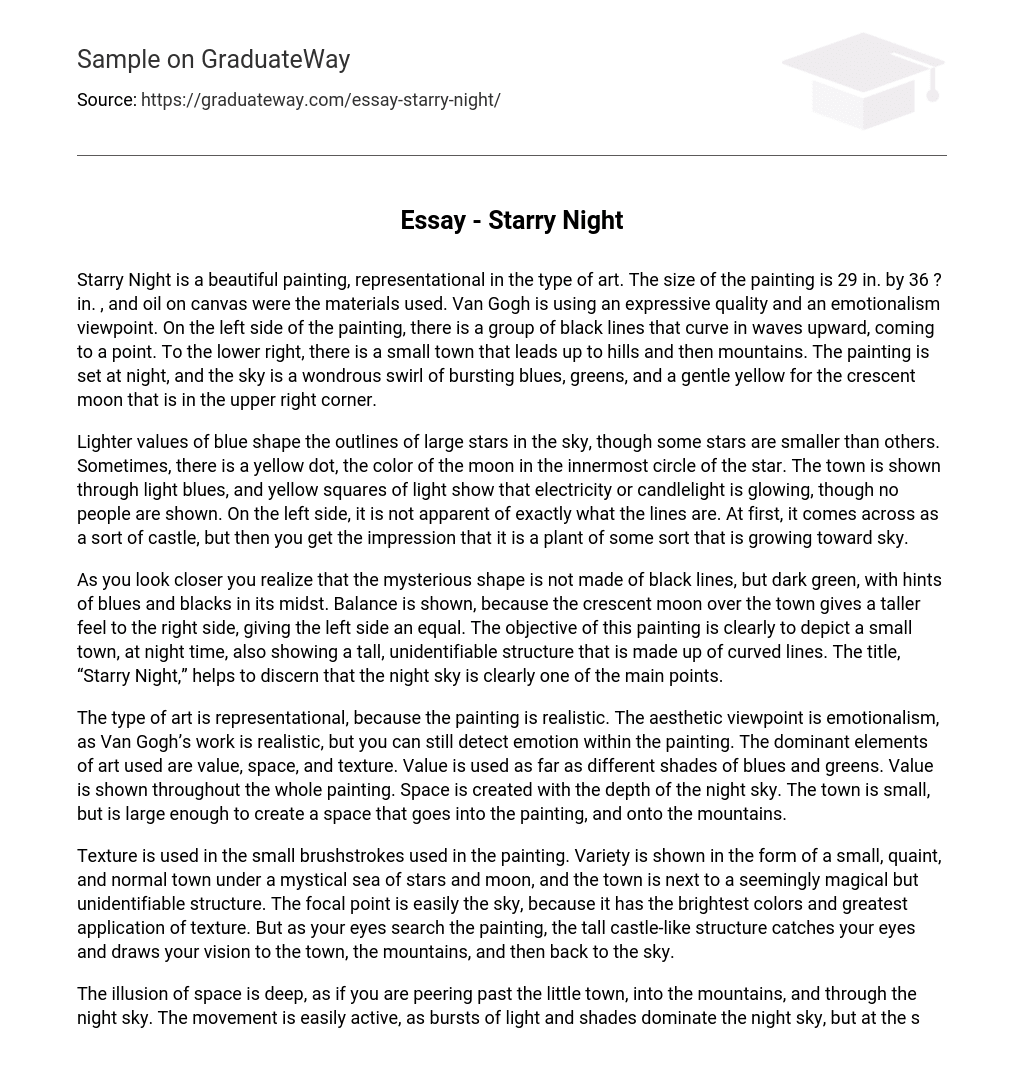Starry Night is a beautiful painting, representational in the type of art. The size of the painting is 29 in. by 36 ? in. , and oil on canvas were the materials used. Van Gogh is using an expressive quality and an emotionalism viewpoint. On the left side of the painting, there is a group of black lines that curve in waves upward, coming to a point. To the lower right, there is a small town that leads up to hills and then mountains. The painting is set at night, and the sky is a wondrous swirl of bursting blues, greens, and a gentle yellow for the crescent moon that is in the upper right corner.
Lighter values of blue shape the outlines of large stars in the sky, though some stars are smaller than others. Sometimes, there is a yellow dot, the color of the moon in the innermost circle of the star. The town is shown through light blues, and yellow squares of light show that electricity or candlelight is glowing, though no people are shown. On the left side, it is not apparent of exactly what the lines are. At first, it comes across as a sort of castle, but then you get the impression that it is a plant of some sort that is growing toward sky.
As you look closer you realize that the mysterious shape is not made of black lines, but dark green, with hints of blues and blacks in its midst. Balance is shown, because the crescent moon over the town gives a taller feel to the right side, giving the left side an equal. The objective of this painting is clearly to depict a small town, at night time, also showing a tall, unidentifiable structure that is made up of curved lines. The title, “Starry Night,” helps to discern that the night sky is clearly one of the main points.
The type of art is representational, because the painting is realistic. The aesthetic viewpoint is emotionalism, as Van Gogh’s work is realistic, but you can still detect emotion within the painting. The dominant elements of art used are value, space, and texture. Value is used as far as different shades of blues and greens. Value is shown throughout the whole painting. Space is created with the depth of the night sky. The town is small, but is large enough to create a space that goes into the painting, and onto the mountains.
Texture is used in the small brushstrokes used in the painting. Variety is shown in the form of a small, quaint, and normal town under a mystical sea of stars and moon, and the town is next to a seemingly magical but unidentifiable structure. The focal point is easily the sky, because it has the brightest colors and greatest application of texture. But as your eyes search the painting, the tall castle-like structure catches your eyes and draws your vision to the town, the mountains, and then back to the sky.
The illusion of space is deep, as if you are peering past the little town, into the mountains, and through the night sky. The movement is easily active, as bursts of light and shades dominate the night sky, but at the same time, the town is calm and simple. The visual balance is symmetrical. Though the black lines draw the eye, the crescent moon above the town balances the painting. Parts of the painting, though surreal, fit together because they are all in the same setting: night time.
As said in the focal point, the parts of the painting flow into one another. The artist is saying that he loves the glow of the moon on a mountaintop, the mystery of a castle, the quaintness of a small town. The artist is drawing from within to create emotion and spirit. The meaning of the painting is along the lines of peacefulness and serenity. I would not expect this town to be full of crime or noise. Even if it was, this is not what the artist depicted. What he did depict was a town, some houses with twinkling lights, others dark with the peace of sleep.
But energy in the painting lives, with the stars glistening like small suns. I see that the painting expresses a dark mood, but happy at the same time. I mean this in the way that night has darkness, but light intrudes, creating a feeling of calm beauty. This work is successful. It certainly met its objective, which was to portray a small town at night, with a brilliant sky and a tall and beautiful but unidentifiable structure. This painting is fairly realistic, so as far as the type of art, the objective was met.
However, emotionalism is also an objective, because the artist imitates reality, but also draws inward for emotion. Good balance is shown in the painting, I would say it is symmetrical. Rhythm is also well shown, as you gaze at the painting, your eyes moving around as each part flows into another. Emphasis is shown on the night sky and the great black figure. Proportion is difficult to describe, as it is difficult to discern just how big the black figure really is. Variety in the mystical castle and the quaint town is well shown.
Harmony is shown in the way that parts of the painting come together. Space, value, texture, and shape are the dominant elements of art, as stated in the analysis. I love this work of art because I love the night so much, particularly in this painting, with its bursts of light and color. I also love mysteries, and the structure on the left side of the painting is definitely a mystery to me. I find that this painting is a new favorite of mine, because of its beauty. It is an exceptional work of art.





